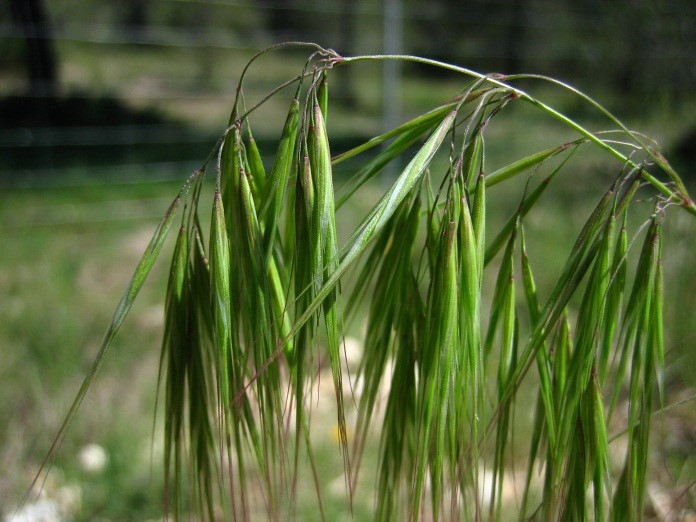Are You My Mother?
 Domain- Eukarya
Domain- Eukarya
Kingdom- Plantae
Phylum-Magnoliophyta
Class- Liliopsida
Order- Cyperales
Family- Poaceae
Genus- Bromus
Species- Bromus tectorum
The generic name Bromus is derived from the Latin bromos, and bromos means "oats". The specific name tectorum has a Latin origin meaning "roofing". With Bromus tectorum having so many other common names it is hard to say what its true translation means as a whole. However, when looking at the word origins separately we get “oat roofing” which could refer to the fact that the leaves of the grass look like that of oats, and the fact that it is so abundant and invasive that it covers the ground in its seeds once it dries out acting like a roof to the top soil (Borror 1960).
Domain: Eukarya- Organisms in the Eukarya domain contain a “true nucleus” along with many membrane bound organelles. This vast domain includes fungi such as the jelly ear mushroom or black bread mold along with animals such as the red-eyed tree frog.
Kingdom:Plantae-
Bromus tectorum belongs under kingdom plantae because it is
a living multicellular organism that has a cell wall made of
cellulose. Another reason it belongs here is because it acquires
most of the energy it needs from sunlight via photosynthesis.
Phylum: Anthophyta-
Bromus tectorum belongs to the Magnoliophyta domain because it is a
flowering plant or angiosperm and has leaves, stems, and roots
(primary growth).The organisms in this phylum such as the
kiwifruit,the
sugar maple, and even
macadamia nuts also produce seeds
encapsulated in a seed coat.

Class: Liliopsida-
Members of this class are all monocots. It is a major characteristic
to flowering plants and it means that they have one cotyledon. A
cotyledon is part of the embryo within the plant and it helps this
plant reproduce so quickly. Besides Bromus tectorum, another
organism that is in this class is the
curly leaf pondweed.
Order: Cyperales-
Angiosperms in the Cyperales order are either wind- or self-
pollinating flowers. These plants are composed of two-or–three
carpellates all leading to a single chambered ovary. A carpellate,
also known as the pistil, consists of the female reproductive organs
including a stigma, style, and ovary. Along with that, the flowers
are arranged in spikelets forming inflorescence. This means the
flowering portions of the plant are clustered together and extend
out from a main branch, like
common
wheat.
Family: Poaceae-
Everything under the family Poaceae is a monocotyledonous flowering
plant more commonly known as a grass. More specifically they have
hollow stems with parallel veins running through it. They also have
leaves that sprout at the nodes, alternating every other side to
maximize absorption of sunlight.
Genus: Bromus- The
Bromus genus is comprised of roughly one hundred and fifty
different grass species! It is part of the grass family and is also
considered a cool-season grass. These grasses are native to
temperate regions.
Species: Bromus tectorum-
The species, Bromus tectorum was placed here and separated
from all other of its genus because it is an alien species. It acts
in extremely peculiar ways by invading every land area that it is
introduced to. In turn, causing harm to the soil, pushing other
species out, and starting wild fires. Just so it can continue to
take over.
Information cited from (PLANTS 2014).

This phylogenetic tree displays the evolution of the order
Cyperales, which Bromus tectorum can be found in. The flow of
Cheatgrass is marked in bold starting from the major clade and
ending with the order that Cheatgrass belongs in. Organisms in the
Cyperales order are characterized by their two-or-three carpellate
all leading to an ovary, or a cluster of flower spikelets(PLANTS
2014). The cyperales order can be further divided into two families.
These families include Poaceae and Cyperaceae. Cheatgrass is a part
of the Poaceae family because it is a grass with hollow stems
(PLANTS 2014).
The Genus Bromus can be broken down into seven
different sub-genuses that can further be broken down into species as displayed in this phylogenetic tree. Since there is much complexity regarding the organism, no
world-wide taxonomy exists for the Genus Bromus (Williams
et al. 2011). The categoric breakdown we have chosen to display
below was created by Smith (Smith 1970). Each sub-genus varies
in species abundance.
Bromus tectorum belongs to the Genea sub-species. The seven species in the sub-genus Genea are those native to the mediterranean. These species that make up Genea are also self-fertilizing and have ploidies ranging from 2x to 8x. (Williams et al. 2011) Bromus tectorum belongs to the the diploid group (Williams et al. 2011).
